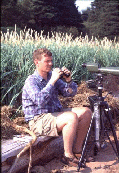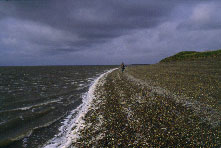 |
Pilot Study 1999 'Sea of Okhotsk': Falk Hüttmann (Ph.D., Diplom-Forstwirt univ.) Postdoc Fellow, Simon Fraser University |  |
Falk Hüttmann
Centre for Wildlife Ecology, Biology Dept.
8888 University Drive, Simon Fraser University, Burnaby B.C., Canada V5A 1S6
Tel: 604 291 5618 Fax: 604 291 3496
Email: huettman@sfu.ca
(I HAVE TO APOLOGIZE, THIS PAGE IS STILL UNDER CONSTRUCTION; I WOULD APPRECIATE ANY FEEDBACK, COMMENTS AND SUGGESTIONS!)
As published in 'THE TATTLER' (1999, Vol. 21, electronic version) Australasian Waders Study Group
Sea of Okhotsk Study
A first summary from a Pilot Project in the Sea of Okhotsk region to investigate wader migration in the
fall.
Due to a general lack of fall migration data on waders for the Sea of Okhotsk region (SOFO) on the East
Asian-Australasian Flyway, we visited the Kamchatka and Magadan regions this year to survey waders,
check working conditions and establish closer contact with Russian authorities. With funding from the
Shorebird Action Plan (Wetlands International - Oceania), we completed a pilot project over 5 weeks
from 3 August 7 September 1999. Here is a brief summary of the findings:
Kamchatka
From 13 August 1999 until 20 August 1999 Falk Huettmann (F.H.) and Dr. Yuri Gerasimov (Kamchatka
Institute for Ecology and Nature Management) were able to visit the Moroshechnaya Delta (56o 50' N,
156o 10' E) in Western Kamchatka to investigate and quantify fall migration of waders. Six daily 12 km
beach counts were carried out at low tide covering the extensive mudflats of the Moroshechnaya River,
the spit and the Sea of Okhotsk shore. A seventh count was cancelled because of rain. A constant strong
wind, 10 - 14 m/s, occurred during our stay and sometimes made species identification difficult. Mudflat
counts were done by scanning with a telescope, and most transect observations were made with a
distance information (meters), which allows for detection curves and density corrections. Whenever
possible, all species were scanned for flags, moulting stage, age and sex. This enabled an assessment of
percentage of age classes, number of birds banded etc which helped to determine the turnover of birds
during the study.
We were able to identify a Marsh Sandpiper (Tringa stagnatilis) which is the first documented record for
Kamchatka (photos were taken and await final acceptance by authorities). In addition, we found a Bar-tailed Godwit (Limosa lapponica) with a yellow flag and a metal band (marked in north-west Australia).
We also conducted eight counts (2 - 6 km long) in the tundra of the spit and checked the SOFO shore at
different tidal stages, did sea counts and quantitative beach debris surveys. Mist netting was made
impossible by the strong wind, but we were able to record data from three Great Knots (Calidris
tenuirostris) supplied by local game wardens. The birds were positively identified and measure; stomach
samples etc. were taken and measured also for future analyses. We found that these three adult birds
were feeding on berries from the tundra zone and were relatively light (130 g).
In general, we found that the Moroshechnaya region had high numbers of Bar-tailed Godwit and Dunlin
(C. alpina); medium numbers of Whimbrel (Numenius phaeopus), Red-necked Stint (C. ruficollis) and
Great Knot and lower numbers of Mongolian Plover (Charadrius mongolus), Oystercatcher
(Haematopus ostralegus) and Greenshank (T. nebularia). Only a very few individuals of Ruddy
Turnstone (Arenaria interpres, numbers increased during our stay), Far Eastern Curlew (N.
madagascariensis), Grey-tailed Tattler (T. brevipes), Lesser Golden Plover (Pluvialis fulva), Grey Plover
(P. squatarola), Common Sandpiper (T. hypoleucos), Terek Sandpiper (Xenus cinereus), Common Snipe
(Gallinago gallinago), Black-tailed Godwit (L. limosa), Red-necked Phalarope (Phalaropus lobatus) and
Red Knot (C. canutus, only four), were observed. Spoon-billed Sandpiper (Eurynorhynchus pygmeus)
and Long-toed Stint (C. subminuta) were not observed, but their occurrence in the area is likely and we
might have overlooked them due to the strong wind.
Below is a representative scan count held on 18 August 1999 at low tide, for a 12 km transect around the Moroshechnaya Spit (river mudflat and SOFO beach):
- N. madagascariensis 5
- N. phaeopus 55 (+ 403 birds in the Tundra during a 5km transect, 11:00am-12:15pm)
- C. lapponica 3509
- C. tenuirostris 1057
- C. alpina 1630
- C. ruficollis 616
- Ch. mongolus 74
- A. interpres 13
- Pl. fulva 0
- H. ostralegus 51
- T. nebularia 6
- N. phaeopus 55 (+ 403 birds in the Tundra during a 5km transect, 11:00am-12:15pm)
100 benthos samples were collected from the mudflats of the Moroshechnaya River and the spit; they are
currently being analysed. Droppings and food items including several berry species, were collected.
Originally we had planned to visit two additional sites, but due to unexpected problems including broken
boat engines, unavailability of boats for rental from a near-by fishing village, severe weather conditions
and lack of visiting permits for the other areas, these trips were unfortunately not possible.
F.H. was able to visit a beach on Eastern Kamchatka close to Northern Petropavlovsk and carried out two
1-hour beach counts. Whimbrel, Great Knot and Red-necked Stint were seen in low numbers (< 100
birds for each species), the latter species was feeding on collembolans which were collected for species
identification (in progress),. Whimbrel droppings found in low concentrations on the beach contained
berries. In Kamchatka, we did not see any other birds (for example, Dunlins) with colour bands.
Magadan Region
In collaboration with Dr. Alexander Andreev and Dr. Igor Dorogoy (Institute for the Problems of the
North), F.H. was able to visit five sites near Magadan (59o 30' N, 151o E) from 26 August - 5 September
1999. Ola Lagoon (ca. 35 km east of Magadan, river mouth and end of Lagoon, 5 visits at low and high
tide), Yana River delta and upriver (ca. 100 km west of Magadan: 2 low tide visits), Arman River delta
and upriver (ca. 50 km west of Magadan: 1 low tide visit), and two sites at Magadan beach during low
tide (Dukcha River and Magadanka River).
Altogether 70 benthos samples were collected at these sites. They were kindly analysed by Dr. Kyra
Andreeva (Regel); further quantitative and qualitative work on this subject is in progress.
Igor videotaped feeding birds. We were able to carry out scan counts for the mudflats, estimate
abdominal profiles (an assessment of fat build up prior to migration), and, at the Ola Lagoon, examine
six Great Knots in the hand. They were then were processed like the samples in Kamchatka. Stomach
contents indicate that these birds fed on crustaceans, rather than berries cf. Kamchatka. The Magadan
beaches had no waders. No large numbers of waders were found on the Arman River (strong freshwater
inflow), but flocks of Great Knot (300 - 500) and Dunlin (up to 800) were observed at the Yana River
and Ola Lagoon. Mongolian Plover, Grey-tailed Tattler, Grey and Lesser Golden Plover were found in
lower numbers. Mostly due to the help of Igor, we finally observed Red Knot, Sanderling (C. alba),
Long-toed Stint, Ruff (Philomachus pugnax), Wood Sandpiper (T. glareola) and Sharp-tailed Sandpiper
(C. acuminata) (< 10 birds for each species). Only five Bar-tailed Godwits were seen at Yana River.
Surprising were the wide variations in abdominal profiles and body weights for Great Knot (80 - 170 g);
no more than 10% of observed Great Knot were juveniles. Birds in wing moult were not observed, colour
bands or flags were not found, and most waders had already moulted into winter plumage. A changing
percentage of juvenile Dunlins, and a change in the low percentage of Dunlins still in full breeding
plumage observed during our stay, could indicate that birds stay only a few days in the area and migrate
in waves.
Below is a list of birds counted on a 2 km transect in the mouth of the Ola Lagoon, 29 August 1999 at low tide:
- C. lapponica 2
- C. tenuirostris 280
- C. alpina 350
- C. ruficollis 5
- Ch. mongolus 14
- A. interpres 4
- Pl. fulva 4
- H. ostralegus 0
- T. nebularia 18
- T. brevipes 4
- P. squatarola 2
- C. tenuirostris 280
For all sites visited, land-based sea counts were carried out; the Moroshechnaya spit contained larger
numbers of loafing Slaty-backed Gulls (Larus schistisagus), Common Gulls (L. canus) and Black-Headed Gulls (L. ridibundus). The two river deltas at Magadan beach also carried large numbers of gulls,
(>10 000 birds; species as above, but higher percentage of Glaucous Gulls, L. hyperboreus; gulls were
mostly in full moult or winter plumage).
We were also able to identify conservation threats for waders at the sites visited, such as salmon fishing,
hunting, pollution from mining and potential oil exploration..
In addition to Dr. Nick Gerasimov, Dr. Yuri Artukhin and Dr. Eugene Lobkov in Petropavlovsk, F.H.
was able to meet and contact other Russian authorities on shorebird issues such as Dr. Pavel Tomkovich
from the Zoological Museum of Moscow State University, and Dr. S. Karithonov from the Russian Bird
Banding Office.
Papers on this visit are currently in progress, a full report of the trip should be ready by end of November
and a website is planned. Currently, we are also trying to compile with our Russian collaborators, a full
literature review of Russian and English papers about the fall migration of shorebirds for the area.
While the diversity of birds met expectations , numbers were much lower than expected. Currently we
cannot not provide an explanation but we stress that our counts cover only two regions, a short time
period and one field season. SOFO seems to play a role as part of a moulting area, but it is not known
whether the moult begins in the breeding grounds. Due to the huge area - SOFO is over 1500 km wide
and 2500 km long - investigations allowing for a 'complete picture' are difficult to carry out at the
numerous beaches, river deltas and mudflats. They deserve much more effort since these areas can play
an important role as a last stop-over site for waders on their southward migration in the fall.
Plans for future research on fall migration of waders in the SOFO region are currently being discussed
and depend on the evaluation of the results of this years' work, research funds, and support from Russian
hosts. Future work includes finding funds to cover an Australian-based postdoctoral position on this
subject, and strengthening international research networks (e.g. Australia, North America, Japan and
Europe). Work should further address the breeding grounds, Sakhalin Island plus the Amur River delta
for closer investigation, training workshops in Eastern Russia, and capturing (e.g. cannon-netting, mist
netting) and banding birds.
F.H. wishes to express his deep gratitude to all Russian collaborators and to Phil Battley, Danny Rogers,
Mark Barter, Doug Watkins (Wetlands International - Oceania), Tony Diamond, Sophia and Julia Linke,
the Linke-Welte family, Clive Minton's Delaware team, and some unknown weather gods who all helped
tremendously to realise this project!
Travel and field expenses were funded under the Asia-Pacific Shorebird Action Plan: 1998 - 2000, by Environment Australia
Falk Huettmann, e-mail k9wk@unb.ca (now huettman@sfu.ca)
Acknowledgements:
Server: GeoCities
Photo: Falk Huettmann, Kathrin Straeter (Title)
General: Jürgen Kraus, Tony Diamond, Julia Linke
This page hosted by
![]() Get your own Free Home Page
Get your own Free Home Page
© 2001 Falk Hüttmann
Last updated: February 28th 2001 by Falk Hüttmann
URL: http://www.oocities.org/CollegePark/Quad/5377/sofo5.html